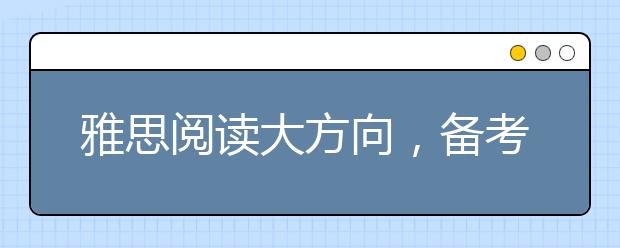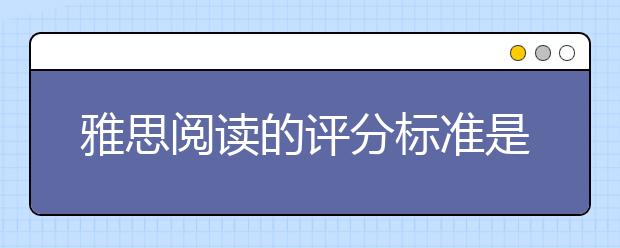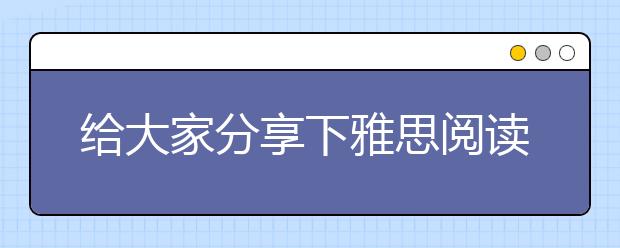雅思阅读话题:人文科学 2023年9月28日雅思阅读考试真题及答案 雅思阅读三篇文章做题顺序怎样合适?很多朋友对这方面很关心,大学路整理了相关文章,供大家参考,一起来看一下吧!
本文目录一览:

雅思阅读话题:人文科学
很多烤鸭们备考雅思阅读的时候发现即使自己背了很多词汇,阅读方法也掌握了不少,但正确率仍旧不是很高,而且速度不够快。通过实际教学经验发现,这其中的一个主要原因在于烤鸭们对于雅思阅读考察的话题不熟悉。为了解决烤鸭们的这个难题,专家对雅思阅读的话题进行了归类总结,让烤鸭们在考场上找到一种“他乡遇故人”的感觉,同时也给出了烤鸭们做阅读的一些方法建议,让烤鸭们在考场上不只是“他乡遇故人”更要“知故人”。
经过对历年的雅思阅读考试的分析,阅读话题主要有两大类,分别是自然科学类和人文社科类。上文中我们已经探讨过自然科学类的话题,本文将重点对人文科学类话题的文章进行分析。雅思阅读人文科学类的话题主要分为三大块:教育类,语言学类,发展史。同时还会涉及到企业管理和心理类。
1. 教育类
首先,教育类的话题一直是雅思考试阅读部分的热门话题。在2011年的考试中,主要涉及到了儿童的性格,欧洲女子教育,儿童心理教育,儿童情感发展,教育方法的研究,噪音对儿童的影响,儿童文学,家长参与教育,天才教育,学习历史的意义。在2012年上半年的考试来看,教育类涉及到了学术道德,阅读方法的探讨,年轻人当父母,澳大利亚文盲。从去年及今年上半年的教育类话题分析,儿童教育及家庭教育是教育类话题的中心。在剑桥雅思真题集中这类型话题的分布也很广泛,比如剑桥5 Test3 passage1 “Early Childhood Education”, 这篇文章主要是关于儿童教育的,讲解了两个项目'Headstart' programme和'Missouri' programme; 剑桥6 Test4 passage2 “Do Literate Women Make Better Mothers?”, 这篇文章讨论了高学历女性是否可以是更好的妈妈,有关儿童的家长问题。剑桥8 Test4 Passage1 'Land of the Rising Sum' 探讨了日本的数学教育。
因此,各位烤鸭应多关注一下这类型的文章,如果没有时间进行课外泛读,也可以对剑桥雅思真题集4-8的教育类文章先进行限时训练,做完对了答案将错误修改之后,建议烤鸭们在这时千万别以为这篇文章就已经做完了,一定要再对整篇文章进行泛读,每段的大意应该知道,并最好用中文标在每段后面,然后把每段主题句中的关键词标出来,如果有不认识的最好摘下来。这样到了考场上才能真正体会到“他乡知故人”,否则,只是遇到了但不够熟悉,做题时仍然会比较困难。
2. 语言类
雅思阅读人文科学类的第二大话题就是语言类。从2011年全年来看,主要涉及到语言的传播,笔译,国际公司的外语策略培训,语言对商业的作用,语言的起源,语言的消失,对语言发展的态度。在 2012年上半年来看,语言类话题主要有交流与文化,语义的理解,双语学习的利弊。从去年到今年上半年,语言类话题主要涉及到了语言对商业,文化等的影响,语言的保护以及语言与教育的结合。这类型话题在剑桥雅思真题集中也有广泛分布,比如:剑桥4 Test2 Passage1 Lost for Words, 这篇文章主要讲解了少数语言的消亡,探讨了语言消亡的原因以及相应的解决办法。除此之外,剑桥4 Test3 Passage3 Obtaining Linguistic Data也是关于语言的,这篇文章相对比较专业化,讲述了获取语料的方法并讨论了这些方法的利弊,但即使这样做这篇文章时也不需要理解那些专业化的词汇。剑桥5 Test2 Passage3 The Birth of Scientific English, 这篇文章结合了语言与发展史,讲述了科学英语的诞生及发展。烤鸭们在遇到这类型的话题时,很多都会觉得相当困难,除非有些烤鸭们的专业就是语言学专业。因为语言学本身就包括了很多分支比如语音学,词汇学,句法学等等。每一个分支都会有很多相关的专业术语,烤鸭们尤其是还在读高中的小烤鸭们会觉得异常难懂,但是要记住一点:雅思考试的一大特色就是“非专业性”。也就是说,虽然考试中会考到很多有关语言学的内容,但是大多是关于语言传播方式,如何保护语言等等比较简单易懂的方面,并不会出现太专业性的内容。即使有专业词汇出现,也应该感到高兴,因为它们不会涉及同意转换。
3. 发展史
第三类的话题就是有关各种事物的发展史。2011年的雅思阅读考试中主要涉及到了欧洲印刷术,古人记事,茶的历史与发展,加拿大移民史,英国战后农业政策,澳大利亚羊毛产业,非洲部落发展等。2012年上半年的雅思阅读考试中主要有管理学之父彼得德鲁克,远古电脑,奥运火炬演变发展,剧院,超市模式的诞生,地图的发展状况,英国人的农业发明-犁地机,小提琴*,库克发现新大陆。这类型话题在剑桥雅思真题集中也有体现,比如:剑桥5 Test1 Passage1 'Johnson's Dictionary', 这篇文章讲述了约翰字典的发展历史,相对来说比较容易理解,而且题目也比较容易做。Test2 Passage1 The Birth of Modern Plastics, 这篇文章论述了现代塑料的发展历程,并讲解了*过程。专业术语较多,但没有同意转换,因此这些专业术语不会影响做题。剑桥7 Test1 Passage2 'Making Every Drop Count', 这篇文章涉及到了人类用水的情况。剑桥8 Test1 Passage1 A Chronicle of Time Keeping, 这篇文章是很典型的发展史类的阅读文章,讲述了计时器的发展历史,讲述的是有史以来不同国家发明的钟表和计时器,也可当作钟表或计时器的发展史来准备这个话题。这类话题是各位烤鸭们必需关注的话题,原因很简单,所有的东西都有历史、有来由,而且这也是近期考试的一个主要话题。考生不可能准备所有的发展史,但是备考过程中完全放弃又很可惜,所以在所有的发展史中,那些曾经考过的发展史考生一定要列为重点准备的内容。比如说“Co*etic Painting”讲述了化妆品发展的历史,从野人时代到现代,但是讲述现代化妆的比较少,主要是对比古代。“人类货币的进化史”,提到了巴比伦货币,中国货币,日本货币,非洲货币等等,以及剑桥雅思真题集上给出的文章一定要做到。
2023年9月28日雅思阅读考试真题及答案
您好,我是专注留学考试规划和留学咨询的小钟老师。在追寻留学梦想的路上,选择合适的学校和专业,准备相关考试,都可能让人感到迷茫和困扰。作为一名有经验的留学顾问,我在此为您提供全方位的专业咨询和指导。欢迎随时提问!
昨天刚刚结束了最新一期的雅思考试,大家有没有被难倒呢?接下来就跟着小钟老师来看一看2023年9月28日雅思阅读考试真题及答案。
Passage1: 希腊硬币Greek coinage
参考答案:
1. 希腊coin早在3000年就出现了=F
2. T
3. Sparta地区侵略Athens并强制Athens用他们的货币=F
4. Great coins在整个欧洲流传=F
5. Persian 入侵了Lydia并且使用人家的硬币=T
6. 用硬币上的头像来奖励做出杰出贡献的人=NG
7. mint
8. stamps
9. anvil
10. reserve dies
11. 希腊硬币的重量至少=0.15g
12. 硬币的图案=the king的头像
13. 希腊被波斯征服之前的花纹是lion and doil
14. coin 在雅典被称为 owl
Passage2: 悉尼交通标识Street markers in Sydney
Passage3: Musical Maladies
参考答案:
A. Music and the brain are both endlessly fascinating subjects, and as a neuroscientist specializing in auditory learning and memory, I find them especially intriguing. So I had high expectations of Musicophilia, the latest offering from neurologist and prolific author Oliver Sacks. And I confess to feeling a little guilty reporting that my reactions to the book are mixed.
B. Sacks himself is the best part of Musicophilia. He richly documents his own life in the book and reveals highly personal experiences. The photograph of him>C. The preface gives a good idea of what the book will deliver. In it Sacks explains that he wants to convey the insights gleaned from the enormous and rapidly growing body of work>complex and often bizarre disorders to which these are prone." He also stresses the importance of the simple art of observation" and the richness of the human context. He wants to combine observation and description with the latest in technology,” he says, and to imaginatively enter into the experience of his patients and subjects. The reader can see that Sacks, who has been practicing neurology for 40 years, is torn between the old-fashioned path of observation and the new-fangled, high-tech approach: He knows that he needs to take heed of the latter, but his heart lies with the former.
D. The book consists mainly of detailed descriptions of cases, most of them involving patients whom Sacks has seen in his practice. Brief discussions of contemporary neuroscientific reports are sprinkled liberally throughout the text. Part I, Haunted by Music," begins with the strange case of Tony Cicoria, a nonmusical, middle-aged surgeon who was consumed by a love of music after being hit by lightning. He suddenly began to crave listening to piano music, which he had never cared for in the past. He started to play the piano and then to compose music, which arose spontaneously in his mind in a torrent of notes. How could this happen? Was I the cause psychological? (He had had a near-death experience when the lightning struck him.) Or was it the direct result of a change in the auditory regions of his cerebral cortex? Electro-encephalography (EEG) showed his brain waves to be normal in the mid-1990s, just after his trauma and subsequent conversion to music. There are now more sensitive tests, but Cicoria has declined to undergo them; he does not want to delve into the causes of his musicality. What a shame!
E. Part II, “A Range of Musicality,” covers a wider variety of topics,but unfortunately, some of the chapters offer little or nothing that is new. For example, chapter 13, which is five pages long, merely notes that the blind often have better hearing than the sighted. The most interesting chapters are those that present the strangest cases. Chapter 8 is about “ amusia, ” an inability to hear sounds as music, and “dysharmonia,”a highly specific impairment of the ability to hear harmony, with the ability to understand melody left intact. Such specific dissociations are found throughout the cases Sacks recounts.
F. To Sacks's credit, part III, "Memory, Movement and Music," brings us into the underappreciated realm of music therapy. Chapter 16 explains how "melodic intonation therapy" is being used to help expressive aphasic patients (those unable to express their thoughts verbally following a stroke or other cerebral incident)>G. To readers who are unfamiliar with neuroscience and music behavior, Musicophilia may be something of a revelation. But the book will not satisfy those seeking the causes and implications of the phenomena Sacks describes. For>appears to be more at ease discussing patients than discussing experiments. And he tends to be rather uncritical in accepting scientific findings and theories.
H. It's true that the causes of music-brain oddities remain poorly understood. However, Sacks could have done more to draw out some of the implications of the careful observations that he and other neurologists have made and of the treatments that have been successful. For example, he might have noted that the many specific dissociations among components of music comprehension, such as loss of the ability to perceive harmony but not melody, indicate that there is no music center in the brain. Because many people who read the book are likely to believe in the brain localization of all mental functions, this was a missed educational opportunity.
I. Another conclusion>patient. Treatments mentioned seem to be almost exclusively antiepileptic medications, which "damp down" the excitability of the brain in general; their effectiveness varies widely.
J. Finally, in many of the cases described here the patient with music-brain symptoms is reported to have "normal" EEG results. Although Sacks recognizes the existence of new technologies, among them far more sensitive ways to *yze brain waves than the standard neurological EEG test, he does not call for their use. In fact, although he exhibits the greatest compassion for patients, he conveys no sense of urgency about the pursuit of new avenues in the diagnosis and treatment of music-brain disorders. This absence echoes the book's preface, in which Sacks expresses fear that the simple art of observation may be lost" if we rely too much on new technologies. He does call for both approaches, though, and we can only hope that the neurological community will respond.
27-30:B C A A
31-36:YES NG NO NG YES NO
37-40:F B A D
希望以上的答复能对您的留学申请有所帮助。如果您有任何更详细的问题或需要进一步的协助,我强烈推荐您访问我们的留学官方网站
,在那里您可以找到更多专业的留学考试规划和留学资料以及*的咨询服务。祝您留学申请顺利!
雅思阅读三篇文章做题顺序怎样合适?
基于每个考生的专业背景知识不同,在拿到试卷后,建议大家首先快速浏览下每篇文章的题目,然后根据你自己的经验,选择一篇自己最容易把握最熟悉的文章。比如,剑桥12中test8中的第三篇题目是:UK
companies need more effective boards of
directors,这个涉及到金融和企业管理方面的话题,很多同学都觉得比较难,但是也有同学正好学金融专业,认为相当简单,对于这类同学,就可以直接从第三篇入手。因为三篇文章之间并没有关联性,也没有固定的难易顺序,所以用这种方式可以让我们从最容易的部分入手,先确保有把握的题目的正确率。
以上就是大学路为大家带来的雅思阅读话题:人文科学 2023年9月28日雅思阅读考试真题及答案 雅思阅读三篇文章做题顺序怎样合适?,希望能帮助到大家!

 如何提高雅思阅读水平,抓住单词与句子难点
如何提高雅思阅读水平,抓住单词与句子难点
 雅思阅读简答题基本解题思路
雅思阅读简答题基本解题思路
 雅思阅读大方向,备考确定好航标
雅思阅读大方向,备考确定好航标
 雅思阅读的评分标准是多少?
雅思阅读的评分标准是多少?
 备战雅思阅读五大技巧
备战雅思阅读五大技巧
 雅思阅读的几大误区,你占了几个?
雅思阅读的几大误区,你占了几个?
 雅思阅读摘要题5大解题步骤讲解分析
雅思阅读摘要题5大解题步骤讲解分析
 雅思阅读不可避免的十大坏习惯
雅思阅读不可避免的十大坏习惯
 给大家分享下雅思阅读评分标准
给大家分享下雅思阅读评分标准
 2021雅思阅读评分标准
2021雅思阅读评分标准









